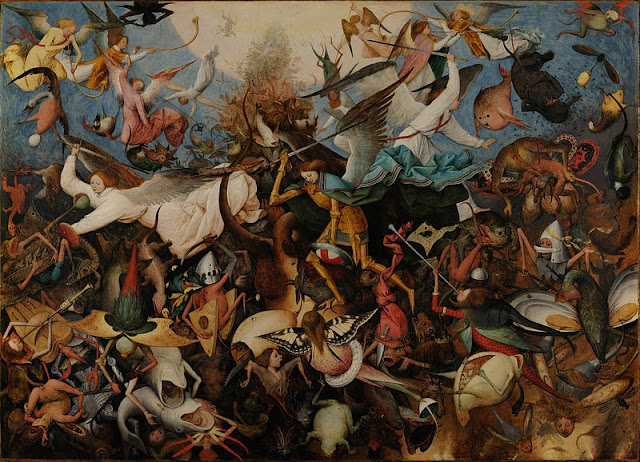Art Insights — The Fall of the Rebel Angels by Pieter Bruegel The Elder
The Dutch-Flemish painter Pieter Bruegel the Elder is one of the artists that shaped up the change of style during his lifetime. One of the pillars of art history, alongside Leonardo Da Vinci, Diego Velazquez, Peter Paul Rubens, Caspar David Friedrich, Vincent van Gogh, Pablo Picasso, and many others. Bruegel the Elder formed his glory with a series of genre paintings, featuring the everyday life of the Dutch and Flemish peasantry.
The Fall of the Rebel Angels is one of the most valuable artworks in the collection of the Royal Museums of Fine Arts of Belgium. It was purchased in 1846, but initially, this painting was wrongly attributed to his son — Brueghel the Younger. Later some thought it to be the work of Hieronymus Bosch. However, the clarity about its author was explored in 1898, when behind the frame there was found the signature — MDLXII / Brvegel. There were no more doubts about its origins.
 |
| The Fall of the Rebel Angels by Pieter Brueghel the Elder. 1562. Oil on oak wood, 117 cm × 162 cm. |
The subject of this painting is as old as the world — the first battle between good and evil. It depicts the story of the origin of Lucifer (Satan) as an angel who rebelled against God in primeval times. The archangel Michael was given the duty to drive Lucifer and the fallen angels out of heaven. The fall of Lucifer and his followers turned them into demons that were doomed for eternal life in hell. The good won this war in heaven, but the evil remained present.
It is no wonder that some wanted to attribute this work to Hieronymus Bosch. You can feel some influence from his works. The Fall of the Rebel Angels has a lot of details, split into two parts. The upper part represents heaven, the lower part — hell. The contrast between both of those is strong. Light tones of heaven eventually fade into darker, brown tones of hell.
In the center of the painting, you can see the archangel Michael in the golden armor and wings. His right foot stands on the stomach of the seven-headed monster. The archangel is ready to make the final blow to the monster and send him to the deepest corners of hell. In the background, there is a spiral of fallen angels awaiting their demonic fate. Michael’s warriors are already blowing their trumpets, being ready to celebrate the victory.
If you take a closer look, Bruegel the Elder depicts a lot of exotic creatures that would be impossible to see or imagine in the Dutch or Flemish lands. However, there is an explanation. The painter lived in the era of great discoveries. During the 16th-century, the exploration of the Americas was on full steam. Its people, nature, and animals became the subject of sketches, drawings, and written scientific works. Bruegel the Elder had heard or seen some of those, and it helped him to portray the creepy creatures falling into hell in a more diverse manner. Of course, it might seem weird that the painter decided to associate newly discovered birds or animals with something demonic. But here you must remember that the exploration of The New World was something historical, and many people were terrified by the things they may never even imagined.
The fallen angels were also depicted with various artifacts, such as weapons, armors, artworks, musical instruments, and the elements of ethnography. The variety of creatures and artifacts just adds up the sense of chaos that is caused by war.
Overall, The Fall of the Rebel Angels is not a painting you would instantly associate with Bruegel the Elder. It clearly represents the influence Hieronymus Bosch had on the Dutch-Flemish painter. We may not know the motifs behind the creation of this artwork, but it is fair to assume that Bruegel the Elder wanted to create something similar to Bosch, to try to position himself in the perspective of the iconic Dutch master. In a way, this painting is an ode to the source of the artist’s inspiration.
For more history content, subscribe to our YouTube channel!
Comments
Post a Comment